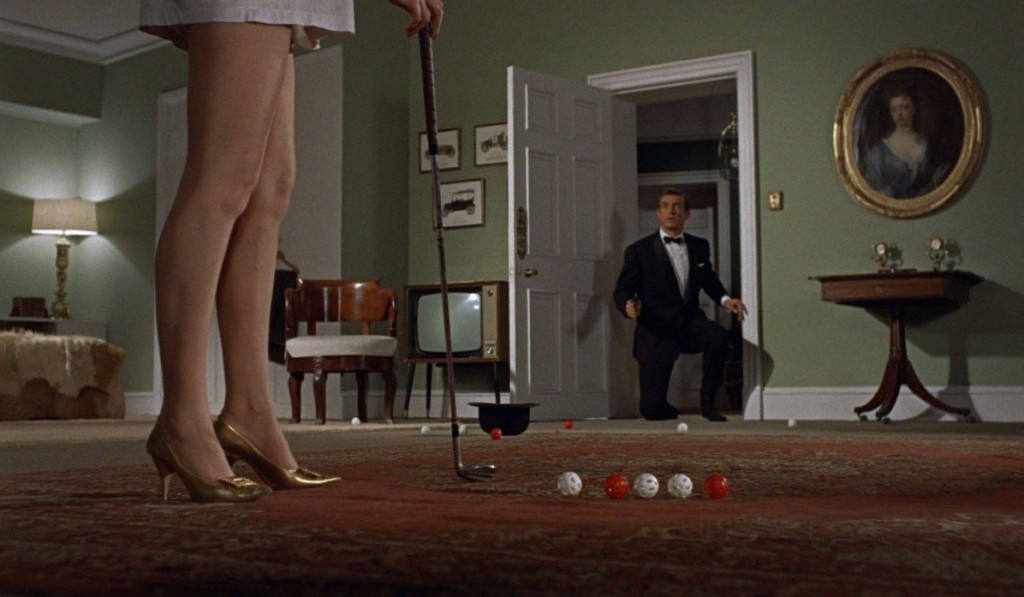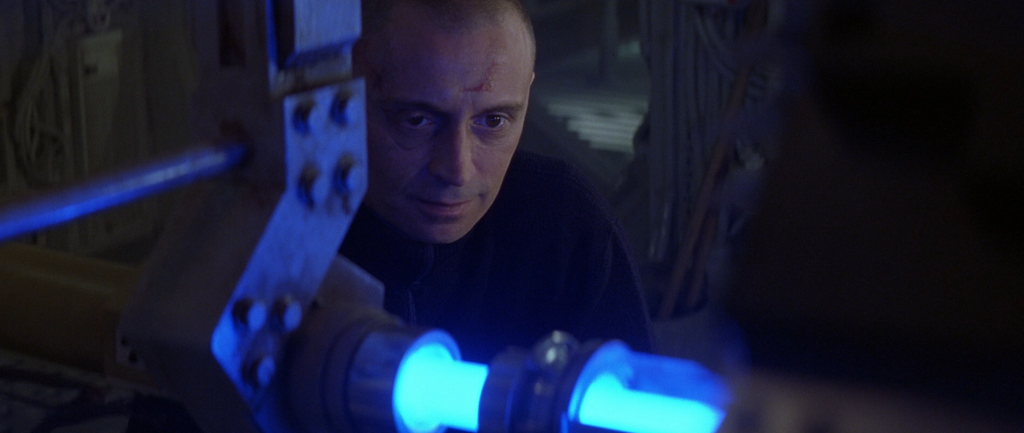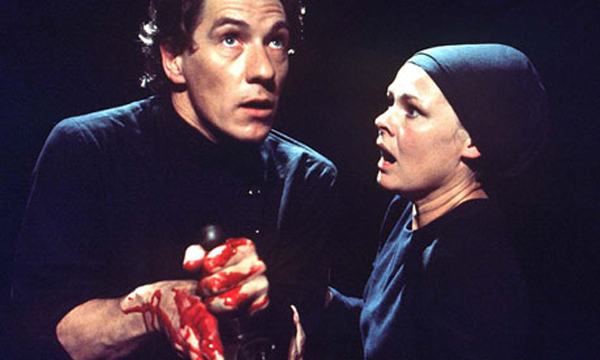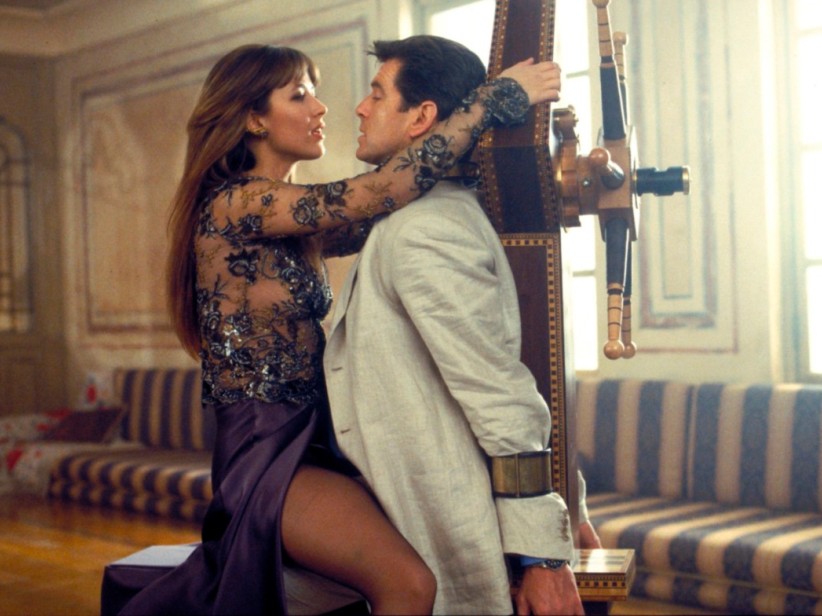This is the 19th essay in a 24-part series about the James Bond cinemas co-created by Sundog Lit. I encourage everyone to read the other essays, comment and join in on the conversation about not only the films themselves, but cinematic trends, political and other external influences on the series’ tone and direction.
Of [In]human #Bond_age_ #19: The Tragedy of The World Is Not Enough: Shakespeare and a Sewer of Misogyny
by James David Patrick
“Something is very wrong with the way American women are trying to live their lives today… [T]he problems and satisfaction of their lives, mine, and the way our education has contributed to them, simply did not fit the image of the modern American woman as she was written about in women’s magazines, studies and analyzed in classrooms and clinics, praised and damned in a ceaseless barrage of words ever since the end of World War Two. There was a strange discrepancy between the reality of our lives as women and the image to which we were trying to conform, the image that I came to call the feminine mystique.”
-Betty Friedan, The Feminine Mystique
“There’s daggers in men’s smiles.”
-William Shakespeare, Macbeth Act II, Sc. III
There’s a temptation to reduce The World Is Not Enough and Die Another Day into one ghastly entity, a turn of the century mistake. I even considered distilling both films into one entry in the #Bond_age_ essay project, focusing on how pandering to the audience through nostalgia and cinematic shorthand can go ever so horribly wrong. I thought this would save sanity. Doing so, however, would be a disservice to TWINE and a marginalization of the DAD’s scourge of terror. First of all, I owe myself a full essay to vent my frustrations, to detail the ways in which Die Another Day curdles the entire Brosnan era and tarnishes Bond for a whole generation of fans. Second, in order to fully appreciate (and perhaps loathe) the ways in which The World Is Not Enough both uses and abuses the Bond formula, we must use a scalpel to peel back the layers of rabble and hyperbole and cut right to the gooey innards. Only then can we dissect what makes that movie tick, what makes it at once more interesting and more loathsome than the average mid- (or bottom-) tier Bond movie.
I first confronted the issue of feminism in James Bond in my discussion about the rape of Pussy Galore in Goldfinger. Ultimately I concluded that the treatment of Pussy Galore was born out of the confused sexual politics of the early 1960’s and the Bond filmmakers’ need to up the titillation factor with each successive Bond film. Again, I stress this does not excuse the questionable abuse, merely provide context and history that could produce a narrative miscalculation, a miscalculation that appears to our eyes brutish and Cro-Magnon. In the 48 years since Goldfinger, the James Bond series has received more than its share of criticism for the treatment and hypersexualization of women, some of it fair, some of it shortsighted and cribbed from hearsay and reputation.
Women threw themselves at Connery after merely a glance, even when they played pro-active roles in the drama. On Her Majesty’s Secret Service remains an outlier – Bond giving himself wholly to a strong, independent woman who also happens to save his skin. Moore had to work (slightly) harder at his womanizing – a quip and a seductive eyebrow. During the Moore years, the series even attempted to place a few of Bond’s female counterparts as de facto equals, in between the 1970’s serial bimboism, of course. Bond became a one-woman (per movie) monogamist during the Dalton years, a direct result of the newly widespread fear of AIDS. GoldenEye presented a mission statement on the ways women would be treated in the Brosnan years – strong, independent, occasionally in-charge, and skeptical of James Bond’s charms. Flash forward four years to The World Is Not Enough and the certainty of this thesis becomes murky and confused, like the enveloping darkness of the facepalm through which you’re forced to watch every line spoken by Dr. Christmas Jones.
The 3-Woman Bond Girl Formula
Like Russian nesting dolls, contained within the well-established “Bond formula” you’ll find other, more specific formulas within other more specific formulas within other specific formulas. 50 years of success allows for narrative guidelines that read like an Ikea manual. The gun barrel, the pre-title sequence, Q Branch dispatch, the villain and his henchman (perhaps the major and the minor villain), or, more relevant to our current conversation, the Three-Girl formula.
Like every Bond formula, the Three-Girl formula provides a baseline for every Bond film’s array of relevant female characters. Individual movies may stray from the formula in order to usurp audience expectation or provide a meta-commentary on the phenomenon, but the narratives never ignore the formulas altogether. To ignore the guidelines would be to create something other than Bond – one of the most damning criticisms for any Bond film by a Bond fan. The “three-girl” formula wasn’t just a critical invention – Roald Dahl first documented the formula as conveyed to him by Cubby Broccoli and Harry Saltzman when he undertook the job of writing You Only Live Twice.
Bond Girl #1: The Idle Liaison. The first Bond Girl is the amuse-bouche, an idle, single-serving, almost complimentary conquest for James Bond. She’ll likely not return to the narrative because she’s deemed irrelevant (Sylvia Trench in both Dr. No and From Russia With Love perfected the role) or because she’s been executed (Strawberry Fields in Quantum of Solace).
Bond Girl #2: The Unfortunate. Often the conflicted girlfriend of the villain or a henchwoman, with whom Bond sleeps with anyway because he’s “pumping” her for information (or he just can’t help himself). This girl will absolutely succumb to some grisly death. Think poor Corinne Dufour in Moonraker who’s attacked by a pack of dogs for cavorting with James Bond.
Bond Girl #3: She Who Goes All The Way. The third Bond Girl will generally survive until the end of the movie, having journeyed with Bond through the rigors and drama of his adventure. Bond has developed affections, has saved her and in turn possibly been saved by her. Since this is the most common type of Bond Girl, it would perhaps be more useful to cite two exceptions to this type: Tracy di Vicenzo in On Her Majesty’s Secret Service and Vesper Lynd in Casino Royale, both of whom must perish before the end of the film because they threaten to derail the institution of James Bond by making him a one-woman man.
Subspecies of Bond Girl #3, The Comrade-in-Arms. A Bond girl who allies herself with Bond because she is fighting for herself or her own interests to reach a similar end goal. Kissy (Mie Hama) in You Only Live Twice.
As You Know… Christmas Comes More Than Once a Year
I might as well put that on the glass right now. Get it out of the way so that I’m not tempted to do something cute with the final line from The World Is Not Enough later on in the proceedings. The longer it goes unsaid, the greater the temptation.
The World Is Not Enough doesn’t fail to present strong female characters. In addition to Judi Dench’s M and Samantha Bond’s Moneypenny, the traditional Three-Girl formula remains, albeit with a couple of anomalous twists.
When Bond was “updated” for the 1990’s in GoldenEye, the film went out of its way to note that Bond was a man out of time. He’s a “sexist, misogynous dinosaur,” a “relic of the cold war.” With that said, however, the movie did not pretend to wholly extinguish that purported sexism. Bond seduces Caroline, the psychiatric evaluator played by Serena Gordon, in his first after credit appearance. The post-feminist Bond movies want to have their cake and eat it, uh, so to speak. Bond will be Bond, even in the 1990’s goddammit. We surf the Internet at speeds approaching 28.8 kilobytes per second, believe Oasis will never break up and acid wash our jeans, but Bond remains a certifiable mid-century womanizer. After Caroline succumbs to Bond’s charms, the movie sets about portraying strong, capable women with enough perspective to criticize Bond for his actions, to rebalance the scale. Judi Dench orders 007 around with an air of condescension. Moneypenny rebuffs Bond with quips about sexual harassment. Xenia Onatopp seduces men and strangles them between her thighs as she reaches audible climax. The male gaze has not necessarily been redirected, but it has been firmly scolded and slapped on the wrist.
The trend continues in Tomorrow Never Dies with Wai Lin, the Bond Girl of variety #3a, a spy of rival prowess (cut from the Barbara Bach/Agent XXX mold) who also shows little interest in taking a ride on Bond’s dinghy. One might even argue in fact that the scene in which they’re handcuffed together on the motorcycle is far more erotic than other legitimate seduction scenes in the James Bond series. Michelle Yeoh’s Wai Lin represents a new standard, but before anyone could get too caught up in reevaluating the dynamics of the Bond girl model in the aftermath of TND, EON went right ahead, upped the ante and dared us to stare into the sun until we bled from our eyes.
…only vaulting ambition, which o’erlaps itself, and falls on the other.
Time to paraphrase a ton of probably unnecessary background reading.
The second-wave feminism of the 1960’s created the “emancipated woman,” an idea heavily influenced by Betty Friedan’s The Feminine Mystique, Gloria Steinem’s freelance journalism and Helen Reddy’s “I Am Woman.” At least this is what Wikipedia says. I must doubt the amount of change that Helen Reddy actually begat, but it’s more fun to include her in the equation.
Where the first-wave dealt with issues of gender equality (suffrage, property rights), the second-wave concerned sexuality, domestic gender roles, reproductive rights and de facto inequalities. The emancipated woman was no longer automatically conscripted into the cult of housewives (no matter their level of education) and was free to do with her sexuality what she pleased. Feminine and independent. The second-wave also considered the imagery of women in popular culture.
In the early Bond films, the conflict between the old hierarchy and the new feminism can be seen on screen through the evolution of the Bond Girl from Ursula Andress to Pussy Galore and eventually Terese di Vicenzo. Ten years later, some of the old gender hierarchies were being reinstated. Postfeminism thus became a reaction to the second-wave and suggested, in part, that women had become too greatly emancipated. I briefly surveyed the 1994 book Who Stole Feminism? How Women Have Betrayed Women by Christina Hoff Summers, that purports feminism had become shortsighted and misandrist. To reduce this complicated cultural reaction to a few paraphrased thoughts, women of the later 1970’s began migrating back into a more comfortable “subordinate position.” The texts I’ve read concerning gender roles and feminism seem to imply that having sewn their wild oats in the 1960’s, reluctantly “liberated” women now wanted to rejoin a “gender stasis.” Hoff Summers calls this course correction “equity feminism.”
You’ll by now have noticed my egregious use of quotation marks. I find it hard to process singular thoughts about this suggested shift in the gender roles. On one hand, radical movements in one direction often incite a reflective counteraction, a shift back towards the center. On the other, I find it hard to believe that the great sexual liberation of the 1960’s ultimately resulted in women frantically searching the attic for the aprons they forgot to burn along with their brassieres. I wonder how much of this shift resulted from life imitating fiction and fiction largely taking on the tentative, confused ideologies of the men from whom the women had supposedly liberated themselves – those predominantly male perspectives in charge of film, television and print. I suppose, in the end, the cause doesn’t matter so much as the bottom line – that by the 1970’s many on both sides of the gender divide were confused about the ultimate outcome of the sexual revolution (listening to a lot of funky disco music and wearing the same cut of bellbottom pants couldn’t have helped clear anything up). After all, I’ve seen Stayin’ Alive and Disco Godfather so I know how it all went down. There’s also the issue of practical reality versus theoretical demagogy to consider.
The Bond movies of the 1970’s and early 80’s provide the perfect conduit for this confusion and uncertainty. It wasn’t just that female characterizations within the same movie portrayed conflicting perspectives – even individual characters couldn’t stick to one agenda. Here’s a snapshot of the most confused Bond girls and movies.
Diamonds Are Forever:
Tiffany Case (Jill St. John): Introduced as a sly, seductive agent-type who used sex to distract the man she believes to be Peter Franks (James Bond, of course) before becoming inept in the field and eventually slipping into a bikini for the final quarter of the movie. She becomes the punchline to a rather elaborate joke about her bum.
Plenty O’Toole (Lana Wood): Her entire purpose is to wear a low-cut dress and lean over the craps table. She portrays a gold digger with huge tracts of land and nothing else going on upstairs.
The Man with the Golden Gun:
Mary Goodnight (Britt Eklund): A secret service staffer who assists Bond in Hong Kong. Capable, right? By the end of the film she’s reduced to eye candy in the Jill St. John bikini stunt and bumbles through the climax, accidentally pushing buttons and endangering lives with her perfect bottom.
Andrea Anders (Maud Adams): Scaramanga’s mistress. And as it turns out the orchestrator of the gimmick to trick Bond into killing Scaramanga. Bond surprises her as she showers. She pulls a gun and escorts him out at gunpoint. Andrea most represents the regrettably “liberated” woman in the 1970’s Bonds. As a penalty of her sexual freedoms, she’s become an indentured sex toy for Scaramanga. She is then prevented from returning to domesticity – in this case, James Bond represents a the safe, Western domestic ideal – when she takes steps to free herself from the bonds of her male oppressor and is executed.
A View to a Kill:
Stacey Sutton (Tanya Roberts): Another example of a professional woman – a scientist in this instance – undermined by the story and the actress playing the role. The narrative turns her into a shrieking damsel in distress while Tanya Roberts proves incapable of displaying any expertise on the topic of geology that hasn’t been read from cue cards. She is described by James Chapman in Licence to Thrill as “a throwback to the worst excesses of 1970’s bimboism.”
I dare do all that may become a man; who dares do more is none
In the Bond oeuvre it must first be understood that women are often pawns in the larger formula and the narrative, disposable cogs in the machine, and therefore the Bond films automatically open themselves up to a certain amount of general criticism. A 2008 BBC News article questioned “Is James Bond loathsome?” In this article, the author, Finlo Rohrer, cites novelist/journalist Bidisha who says, “The Bond films are generally sexist. I don’t like anything that descends from a sewer of misogyny.” Rohrer then goes on to question if James Bond were truly hostile toward women how does one explain the cross-gender appeal?
Because it’s slightly more complicated than that.
Though Bond may have descended from a “sewer of misogyny,” the mango has fallen increasingly further from the tree… and then closer… and then farther… But it should be noted that even in the beginning, the Bond films created female roles more closely aligned with Betty Friedan’s model for the liberated woman. These were independent women who, despite falling truly, madly, deeply into the arms of James Bond did not necessarily aspire to the post-war notion of women as cooks, cleaners and baby factories. Small victories, I admit, but I remain confident in my assertion that the Bond films are not inherently anti-feminist (certainly less so than Fleming’s original stories) and they’re certainly not misogynist, merely hypersexual and neglectful in creating fully formed female characters. One might in turn argue without much difficulty that despite 23 films under his belt, Bond himself has never become fully formed. The series has always been more interested in planting the seeds of villainy rather than exploring what makes James Bond or “his Bond girls” tick.
During that stretch of films beginning in 1971 and concluding in 1985, the James Bond films represented the cultural confusion in the post-feminist landscape, a mélange of sexual empowerment, femininity and pulp exploitation.
Lest ye forget, we were talking about The World Is Not Enough way back at the very beginning of this essay. Four years after GoldenEye’s micro-feminist movement within the Bond series you’d expect a certain amount of progress and creativity regarding the depiction of women. And you’d be right and wrong at the same time. The World Is Not Enough manages to create one of the most fascinating and complex (if not the most complex) female characters in the series while simultaneously undermining the progress with a return to those “excesses of 1970’s bimboism.”
Out damned spot! Out, I say! (aka it’s Elektra, boogie-woogie-woogie)
Elektra King is the daughter of oil tycoon Sir Robert King. When kidnapped as a teenager by the terrorist (Renard) her father refused to pay the ransom as advised by family friend, M. As teenagers do, she lashed our irrationally at her father, becoming Renard’s lover and participating in a plot to extort money from her own family. She even cuts off part of her ear to send via the post as a warning from her kidnappers.
Ten years later, Sir Robert is assassinated by a booby-trapped briefcase full of money – the assassin, in this instance a woman (unnamed Cigar Girl), attempts to escape but is tracked down by Bond and offered protection for information. She refuses, instead detonating the balloon because she believed nobody could protect her from her “employers.” The money is traced to Renard, and Bond believes that the KGB-agent turned terrorist is targeting Elektra a second time. He travels to Azerbaijan, where Elektra is overseeing the production of a new oil pipeline. Sex and violence ensue. As they tend to do.
Without further need to explore the varied intricacies of The World is Not Enough’s narrative and the on-again, off-again concern with Stockholm Syndrome, it should suffice to say that Elektra King is not the damsel in distress that Bond believes her to be. She manipulates him with her sexuality, stringing Bond along until it is believed that he has been blow’d up by Renard in the Kazakhstani pipeline explosion.
Elektra remains unique in the Bond universe because she’s the only major female villain. Some will argue that Rosa Klebb in From Russia With Love qualifies, but I can’t agree. Klebb clearly takes orders from Blofeld. At best, she works in middle management. The femme fatale has long been deployed as henchwoman, but never as a primary villain. In addition to Rosa Klebb, Thunderball’s Fiona and A View to a Kill’s Mayday made for notable, capable adversaries. Turning Bond Girl #2 into the film’s villain with traditional, delusional aspirations provides many moments of inspired narrative and almost offers a bit of commentary about the series’ treatment of women, manipulating the longstanding Bond girl formula to defy expectation. The film even employs a visual red herring – disfiguring Renard, per decades of Bond villains, but concealing Elektra’s disfigurement, her missing earlobe, behind an earring. As trained Bond viewers we’ve been taught that physical disfigurement or deformity means evil. That the film presents Renard and his scars, but conceals Elektra suggests that The World Is Not Enough has made these decisions consciously (we can’t always assume that brilliance comes with intent when discussing Bond) in order to play with the formula and divert audience expectation.
All the perfumes of Arabia will not sweeten this little hand
In terms of creating some sort of commentary about the treatment of women in the Bond series, the series stops short of making any lasting statement. With few exceptions, Bond’s women exist to serve Bond’s mission. They are disposable, a means to an end. And in turn, Bond provides a means by which Elektra plans to reach her own nefarious endgame. Bond has become the pawn, until, of course, he wises up, saves the day and restores order to the Bond universe by executing the woman that threatens the fabric of the formula. The World Is Not Enough deserves credit for testing uncharted water, daring to show Bond deluded by his attraction to Elektra (and who can blame him, am I right?). The film, however, undermines any commentary it might make by employing stock characters from the Commedia dell’bimbo.
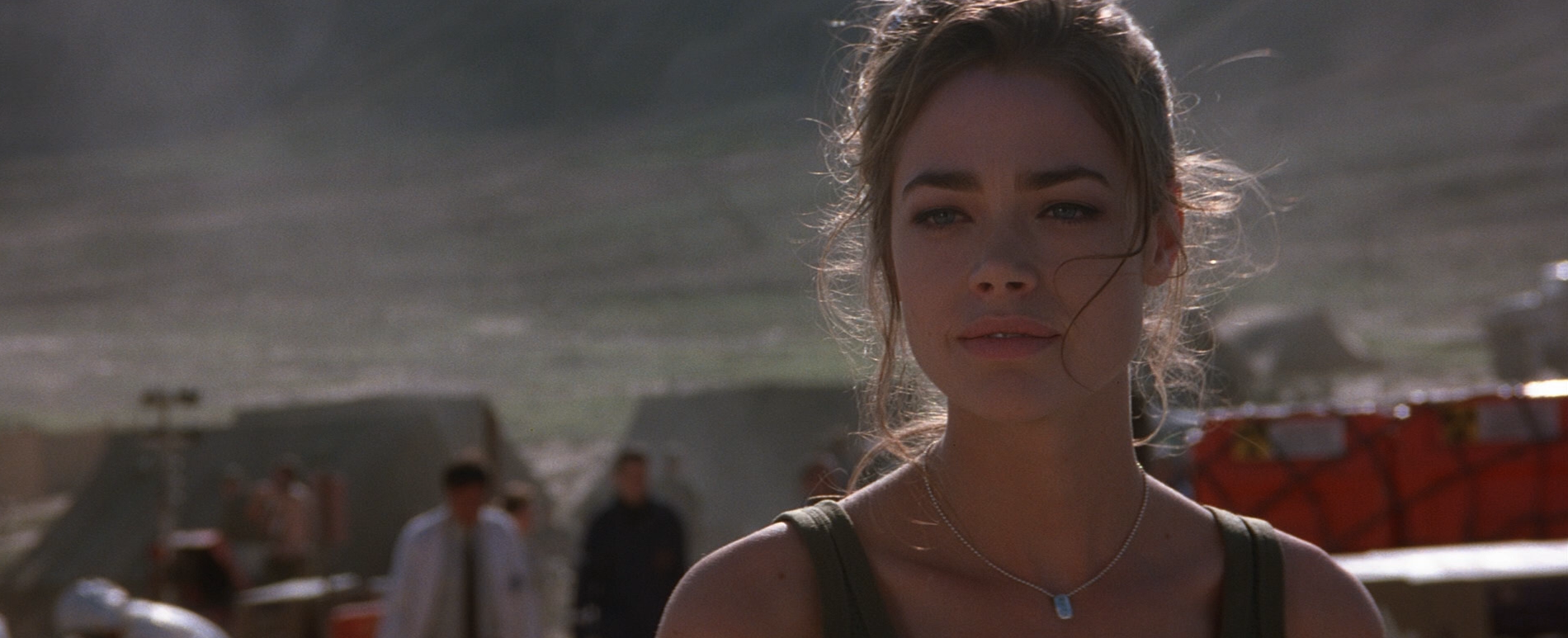
The film goes to great length to establish how women navigate a world of despicable men. Elektra uses her sexuality to manipulate Bond and her kidnappers (“I seduced the guards. Used my body. It gave me control.”) The same sentiment can be seen in M’s explanation for advising Sir Robert King to not pay the ransom: “As you are aware, we do not negotiate with terrorists. And against every instinct in my heart, every emotion as a mother, I told him not to pay the ransom.” To place such precise female empowerment at the center of The World Is Not Enough provides a fascinating spin on a traditional Bond narrative.
Instead of lingering on any intellectual or emotional discourse about Elektra’s betrayal, Bond has been given huge pillows to ease his sorrow. And by pillows I obviously mean Denise Richards’ Dr. Christmas Jones, who, like Plenty O’Toole 28 years before, operates as talking cleavage – only in this instance, Christmas Jones wasn’t offered up as a pulpy, carnival sideshow, she was given prime real estate and a nuclear physicist outfit from Costume World to service the narrative. Played by an actress capable of ending a sentence without a question mark, Christmas Jones could have benefitted TWINE’s female perspective. The character could have conveyed some sense of professional expertise and, if necessary, functioned similarly as one of Bond’s disposable clichés. Other women have managed the very same role without offense. As I sit here typing this analysis of Dr. Christmas Jones contributions to the Bond franchise, I grow more and more aggravated. I don’t blame Denise Richards – although she’s clearly a marginal actress, she had no business being cast in the role. Further commentary on Christmas Jones in light of the vitriol already spewed by fans and critics feels like beating a dead physicist. Instead, let’s return to a lesser-scrutinized character in the film that doesn’t always get the attention she deserves.
Bond beds Dr. Molly Warmflash (Serena Scott Thomas – Kristin Scott Thomas’ little sister) to get a clean bill of health. This recalls the seduction of the evaluator in GoldenEye, a pretty traditional one-off bit of dalliance to showcase Bond’s powers of persuasion. In this instance, however, Moneypenny, who had always yearned for 007 but kept herself distant because deep down she knows he’s loathsome cad, responds with a touch of jealousy. In GoldenEye, Bond’s evaluator seduction had seemed at least in part born of desperation to keep his job and was similarly chastised by M and Moneypenny. Here, Bond catalyzes a catfight between his harem of kept women. This not only undermines the supposed “new direction” of the 90’s Bond, but also the character of Moneypenny – which from the perspective of a certain class of Bond fan proves more egregious than any isolated damage caused by Dr. Christmas Jones.
Life’s a tale told by an idiot, full of sound and fury, signifying nothing
As I’ve toiled over these words, I am increasingly drawn to the ways in which The World Is Not Enough reminds me of Shakespeare’s Macbeth. I do not propose a full dissection of these theories because they are, at best, merely compelling analogies. I present them to the world knowing that scrutiny would only tear at the fabric like an enormous rotary saw blade. Instead, I will leave Lady Macbeth and The World Is Not Enough’s Elektra King merely in close approximation and allow you to draw your own conclusions.
Masculinity in The World Is Not Enough and Macbeth is defined by power and each challenges our preconceived views of traditional gender roles. In Macbeth, it is Lady Macbeth that challenges her husband to act, to become “more of a man” – when it is also she who craves control. Because she is a woman, she is unable to act on her own ambition because of social constraints. Elektra King, likewise, wields control over her former captor Renard (and Bond, to a lesser degree), thus becoming the puppetmaster and Renard her puppet. Forged in Bidisha’s supposed “sewer of misogyny” the Bond films have been beholden to a specific gender hierarchy – we can’t go as far to suggest subordinance because Bond’s conquests do not want to be controlled in the traditional domestic sense. The hierarchy, thus, becomes more extratextual.
By viewing the Bond films as a whole, seeing how they inform one another, certain patterns emerge and certain assumptions crumble. The women in Bond often occupy compelling characters, albeit ones that are created primarily to serve specific sexual and political ideologies that Bond and England will ultimately always come out on top. They are often independent, sexually liberated women who fall madly, deeply (perhaps not truly in love) with the wrong man (God help you if you fall for Craigers’ Bond). Like any recycled element in the 23-film Bond series (or any long running series for that matter), there are ebbs and flows of creative inspiration and socially induced mores. To state that all of Bond is wholly, despicably sexist is to throw the Elektra Kings, Vesper Lynds and Teresa di Vicenzos out with the Christmas Joneses and Plenty O’Tooles; but when the series almost seems to go out of its way to undermine progress, it is our duty to write long-winded essays condemning the lazy tendencies that cause the series to be aligned with the terms “sexist” (which is a probably undeniable for large swaths of the series) or its more offensive cousin, “misogynist.” To reduce the Bond series to any one of these terms would be as lazy and shortsighted as the casting decision that led to Denise Richards playing someone with a PhD.
Congratulations. You made it to the end of that essay. As your reward here’s another picture of Sophie Marceau as Elektra King. And I’m quite certain that this reward doesn’t just apply to the guys out there.
Previous James Bond #Bond_age_ Project Essays:
Dr. No / From Russia With Love / Goldfinger / Thunderball / You Only Live Twice / On Her Majesty’s Secret Service / Diamonds Are Forever / Live and Let Die / The Man with the Golden Gun / The Spy Who Loved Me / Moonraker / For Your Eyes Only / Octopussy / A View to a Kill / The Living Daylights / Licence to Kill / GoldenEye / Tomorrow Never Dies / The World Is Not Enough / Die Another Day / Casino Royale / Quantum of Solace / Skyfall



